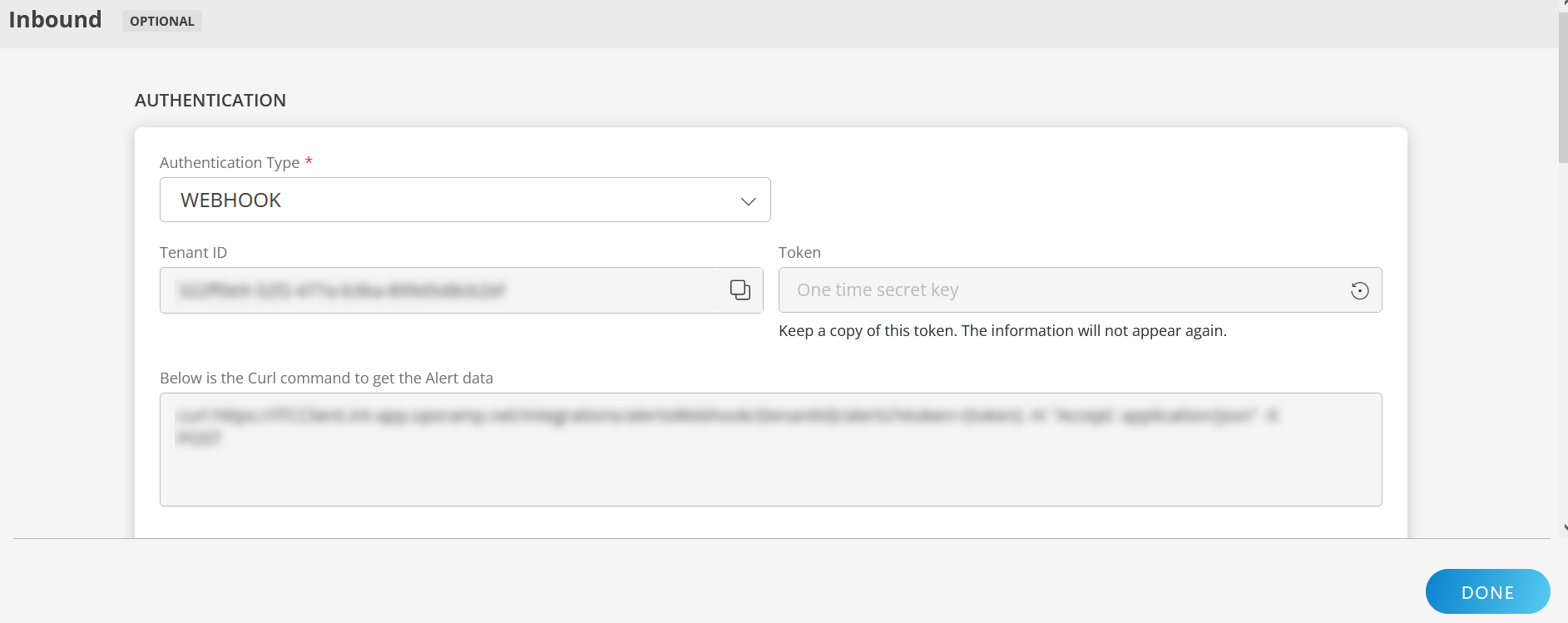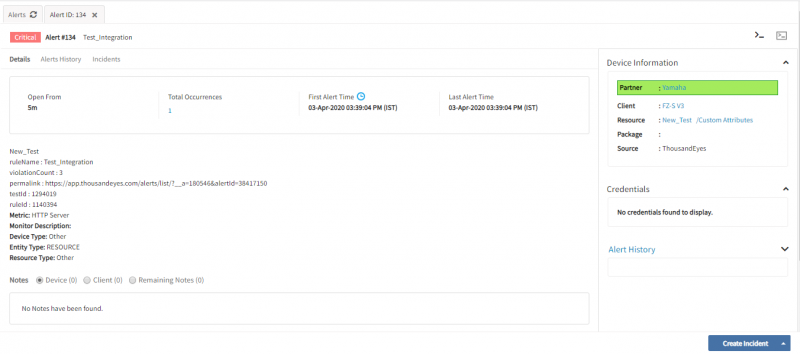ThousandEyes is a network infrastructure monitoring provider. ThousandEyes provides effective troubleshooting of application delivery and maps Internet performance from a SaaS-based platform.
OpsRamp integration supports Webhooks to manage alerts from ThousandEyes monitoring events.
The current ThousandEyes version supported for integration is the March 23, 2020 release.
OpsRamp configuration
Step 1: Install the integration
- From All Clients, select a client.
- Navigate to Setup > Account.
- Select the Integrations and Apps tab.
- The Installed Integrations page, where all the installed applications are displayed. Note: If there are no installed applications, it will navigate to the Available Integrations and Apps page.
- Click + ADD on the Installed Integrations page. The Available Integrations and Apps page displays all the available applications along with the newly created application with the version.
- Search for the application using the search option available. Alternatively, use the All Categories option to search.
- Click ADD on the ThousandEyes tile.
Inbound (Optional):

To configure the inbound, follow these steps:
Authentication:
Select the Authentication Type as Webhook.
- Webhook: By default, Webhook is selected as the Authentication Type.
Make a note of Tenant ID, Token and Webhook URL.
These details are used while creating an HTTP Request template during ThousandEyes configuration.
- Webhook: By default, Webhook is selected as the Authentication Type.
Map Attributes: Map OpsRamp entity attributes with ThousandEyes attributes.
Click +Add from the Map Attributes section.
From the Add Map Attributes window, enter the below information:
- OpsRamp Entity: Select Alert from the dropdown.
- OpsRamp Property: Select the OpsRamp property from the dropdown.
- ThousandEyes Entity: Enter the ThousandEyes entity value in the box and click the +value from the dropdown to add it. You can add multiple values.
- ThousandEyes Property: Enter the ThousandEyes property.
Parsing Condition:
- Click +Add and provide the parsing condition:
- Select an operator from the dropdown and enter a value in the fields accordingly. Based on the operator selected, the fields vary.
- Click Save. Click +Add to add more conditions.
Property Values:
- Click +Property Value.
- Enter a value in the ThousandEyes Property Value box and select the appropriate value from the OpsRamp Property Value dropdown.
The options in the OpsRamp Property Value dropdown appear based on the OpsRamp Property selected. - Click Save.
- Click +Property Value to add more property values.
Default Value: Alternatively, you can enter/select a default value in the box.
Note: To map more attributes, click +Entity.
Click Add Map Attributes. The mapped attributes list is added.
- Click the three dots icon at the end of each row to edit or remove the map attributes.
- Use the Filter option to filter the map attributes.
Additional Settings: Select the Drop alerts from unmanaged resources checkbox if you do not want to trigger alerts from unmanaged resources.
Enrich and Create Alert: Select a process definition from the dropdown. You can customize the incoming alerts according to the properties defined in the process definition.
Click Finish.
The following table describes mapping attributes:
| Third-Party Entity | OpsRamp Entity | Third-Party Property | OpsRamp Property (non-editable) | ||||||||
|---|---|---|---|---|---|---|---|---|---|---|---|
| Problem | Alert | eventType
| alert.currentState | ||||||||
| Problem | Alert | alert.type | alert.serviceName | ||||||||
| Problem | Alert | alert.testName ruleName : $alert.ruleName violationCount : $alert.violationCount permalink : $alert.permalink testId : $alert.testId ruleId : $alert.ruleId | alert.description | ||||||||
| Problem | Alert | alert.testName | alert.deviceName | ||||||||
| Problem | Alert | alert.ruleName | alert.subject |
- Attributes can be modified.
- Mappings are user-selectable and depend on the environment.
ThousandEyes configuration
Step 1: Create test
- Log into ThousandEyes Admin UI.
- From the left pane, navigate to Cloud and Enterprise Agents > Test Settings and click Add New Test. A new test dialog is displayed.
- Perform the following steps for the new test block:
- Select Layer.
For example: Web - Select a Test Type.
For example: HTTP Server - Enter a unique Test Name. The Basic Configuration displays fields according to the selections of the layer and test type.
- Enter the basic configuration details. For example, if the layer is Web, the URL field is displayed. The fields, such as Interval, Agents, and Alerts are common. Select the values accordingly from the drop-down menu and make sure that the Alerts checkbox is selected.
- Without modifying advanced settings, click Create New Test.
- Select Layer.
The new test is added.
Step 2: Create alert rule
- From the ThousandEyes panel, go to Alerts > Alert Rules and click Add New Alert Rule. The Add New Alert Rule dialog box is displayed. Alert Type displays the Layer (Web) and Test Type (HTTP Server) that was selected in step 1.
- Enter a unique Rule Name.
- For Settings, do the following steps:
- From the Tests drop-down, select the name of the newly added test.
- Select the Agents for the new rule.
For example, leave the default selection of None for Auth Type. - In Alert Conditions, specify the conditions (if any) that the alert must meet in the drop-down. To add (or remove) an alert condition, click the + (or -) button.
- Perform the following steps on the Notifications tab to configure Webhook URL and add:
- For Webhooks, do the following steps to Edit webhooks for send notifications:
- Enter a unique name.
- Enter the Webhook URL copied during OpsRamp.
For example,[https://example.opsramp.com/integrations/alertsWebhook/{tenant Id}/alerts?vtoken=Vdslfndnx93Y2cK7FsxG8qp2StKb](https://{yourdomain}:/integrations/alertsWebhook/client_1/alerts?vtoken={token}). - Click Test to verify the Webhook URL.
- Click Add New Webhook.
- Select the Webhook URL created from the drop-down menu.
- For Webhooks, do the following steps to Edit webhooks for send notifications:
- Click Save Changes.
The new alert rule is created.
Example payload
{
"eventType": "ALERT_NOTIFICATION_TRIGGER",
"eventId": "105777903-38417150",
"alert": {
"agents": [
{
"active": 1,
"metricsAtStart": "Error: "404 Not Found"",
"metricsAtEnd": "",
"agentId": 48608,
"agentName": "Atlanta, GA (Trial) - IPv6",
"dateStart": "2020-04-03 06:18:03",
"permalink": "https://app.thousandeyes.com/alerts/list/?__a=180546&alertId=38417150&agentId=48608"
},
{
"active": 1,
"metricsAtStart": "Error: "404 Not Found"",
"metricsAtEnd": "",
"agentId": 4512,
"agentName": "Atlanta, GA (Trial)",
"dateStart": "2020-04-03 06:18:03",
"permalink": "https://app.thousandeyes.com/alerts/list/?__a=180546&alertId=38417150&agentId=4512"
},
{
"active": 1,
"metricsAtStart": "Error: "404 Not Found"",
"metricsAtEnd": "",
"agentId": 4516,
"agentName": "New York, NY (Trial)",
"dateStart": "2020-04-03 06:18:03",
"permalink": "https://app.thousandeyes.com/alerts/list/?__a=180546&alertId=38417150&agentId=4516"
}
],
"alertId": 38417150,
"dateStart": "2020-04-03 06:18:03",
"apiLinks": [
{
"rel": "related",
"href": "https://api.thousandeyes.com/v4/tests/1294019"
},
{
"rel": "data",
"href": "https://api.thousandeyes.com/v4/web/http-server/1294019"
}
],
"permalink": "https://app.thousandeyes.com/alerts/list/?__a=180546&alertId=38417150",
"ruleExpression": "Error is present",
"ruleId": 1140394,
"ruleName": "Test_Integration",
"testId": 1294019,
"testName": "New_Test",
"violationCount": 3,
"type": "HTTP Server"
}
}Viewing alerts
- Select the Workspace drop-down option and go to Alerts.
- Search for ThousandEyes as the source name to view alerts.
- Click an alert ID.
